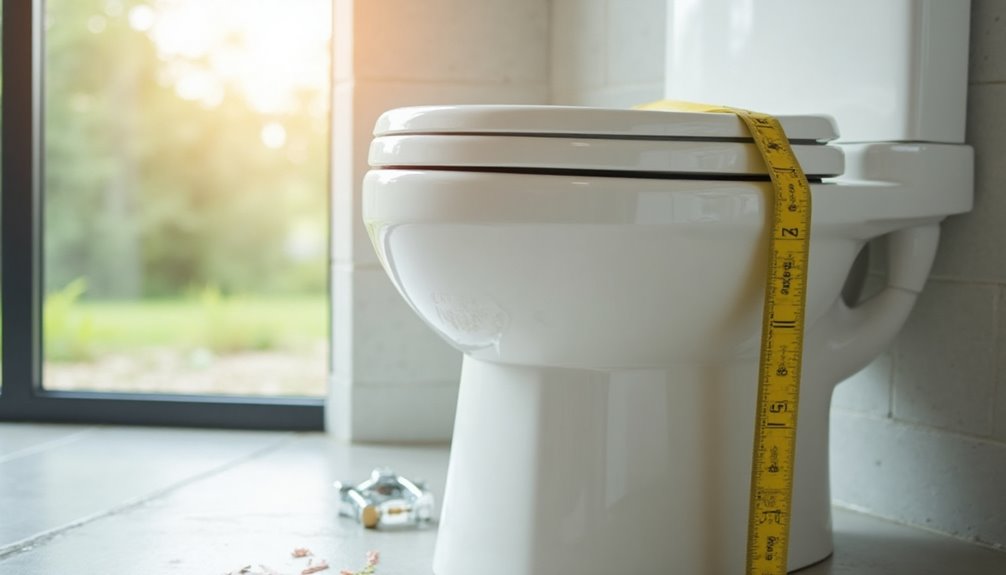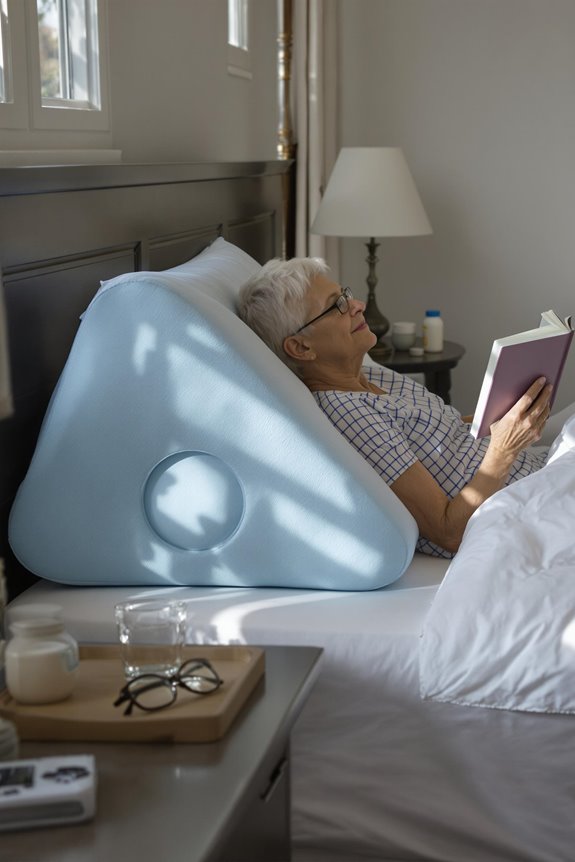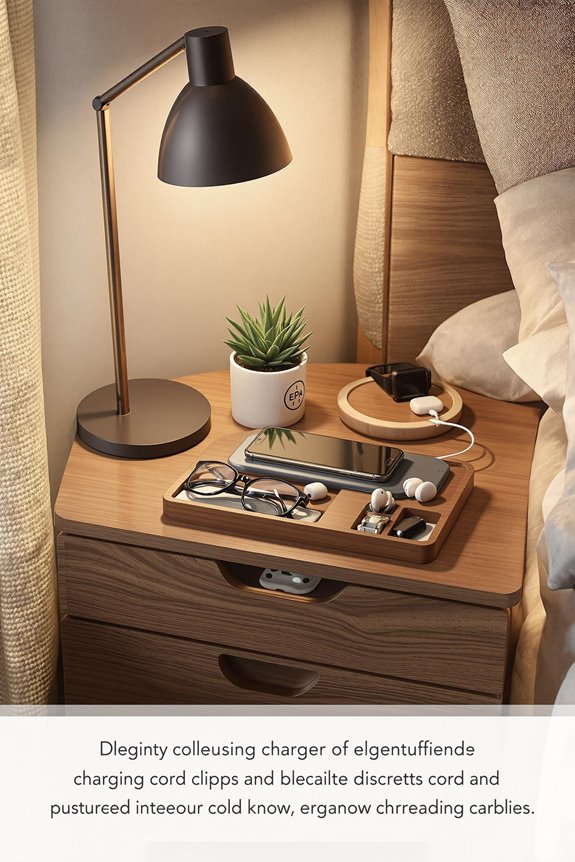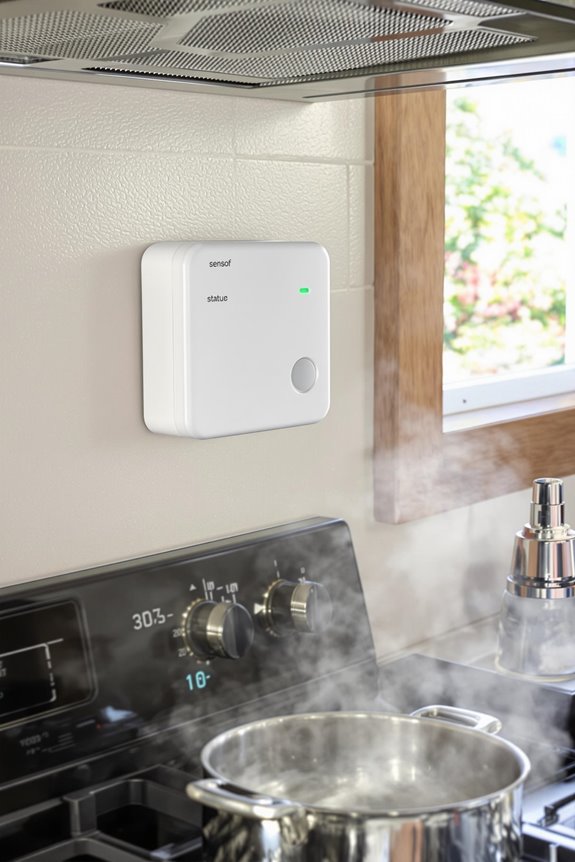When you’re considering a bathroom upgrade, comfort height toilets might be on your radar. These taller fixtures, standing 17-19 inches from floor to seat, offer significant benefits for aging adults and those with mobility issues. Yet, they’re not universally ideal for every household member. Understanding the proper measurements for installation and knowing who will benefit most from these elevated seats can make a substantial difference in your daily comfort and accessibility. What factors should you weigh before making this investment?
Key Takeaways
- Comfort height toilets stand 17-19 inches tall, making them 2-4 inches higher than standard toilets for easier sitting and standing.
- They benefit seniors, individuals with mobility issues, and those recovering from hip or knee surgery by reducing joint strain.
- Installation requires at least 18 inches from toilet center to sidewalls and 30 inches of clear space in front.
- Shorter individuals under 5’4″ may find these toilets uncomfortable as their feet might not touch the floor.
- Costs range from $150-$400 for the toilet itself, with professional installation adding an additional $200-$350.
Comfort Height Toilets
When families explore aging-in-place modifications, comfort height toilets often top the list of beneficial bathroom upgrades.
These fixtures, sometimes called “right height” or “chair height” toilets, stand between 17-19 inches from floor to seat, compared to standard toilets at 14-15 inches. This extra height makes a significant difference for seniors with mobility challenges or joint pain.
The main advantage of comfort height toilets is reduced strain when sitting down and standing up. For many older adults, this simple modification eliminates a daily struggle and helps maintain independence in the bathroom.
While installation costs are comparable to standard toilets, the accessibility benefits are substantial.
When considering this upgrade, measure your loved one’s current toilet height and observe if they’re using adaptive equipment like raised seats—clear indicators that a comfort height toilet might be appropriate.
What it is and the daily problems it solves
As you help your parents age in place, understanding what a comfort height toilet actually is becomes vital for their daily independence.
Also called “right height” or “chair height” toilets, these fixtures stand 17-19 inches from floor to seat rim, compared to standard models at 14-15 inches.
This increased height solves several daily challenges for seniors. The taller design reduces the depth of sitting and standing, minimizing strain on knees, hips, and backs.
For those with mobility concerns, this simple adjustment can restore comfort and confidence in bathroom routines.
Most importantly, comfort height toilets are an essential fall prevention tool. The reduced distance traveled when moving from standing to seated position provides greater stability, especially important for older adults with balance issues or recent surgeries.
Who benefits and when to use it
While many bathroom modifications require careful consideration, comfort height toilets offer nearly universal benefits for aging adults.
These elevated fixtures (typically 17-19 inches from floor to seat) are ideal for anyone experiencing mobility challenges, joint pain, or balance issues.
Comfort height toilets provide critical accessibility benefits for those with mobility limitations or chronic pain.
Seniors who struggle with standing up from seated positions will find these toilets particularly helpful. They’re also valuable for adults recovering from hip or knee surgery, those using walkers or wheelchairs, and anyone with arthritis or back pain.
When planning for aging in place, a comfort height toilet often makes sense as an early modification since it’s relatively affordable and non-invasive compared to other bathroom renovations.
The minimal cost difference between standard and comfort height models makes this an accessible starting point for creating safer, more comfortable living spaces. Additionally, assisted living facilities often incorporate such modifications to enhance residents’ comfort and independence.
Key features to look for
Let’s now look at the essential features you’ll want to contemplate when shopping for a comfort height toilet.
Finding the right combination of functional elements can make a significant difference in both safety and convenience.
I’ve put together a practical feature checklist to guide your decision-making process.
Feature checklist
Every comfort height toilet offers different features, so you’ll want to know exactly what to look for when shopping for your parents. As you compare options, focus on elements that maximize comfort, accessibility, and maintenance.
The best comfort height toilets will combine several key features that make daily living easier for seniors.
- Height measurement (17-19 inches from floor to seat top)
- Soft-close lid mechanism to prevent slamming
- Elongated bowl shape for easier transfers
- One-piece design for simpler cleaning and fewer leak points
Remember that installation costs typically run separate from the toilet purchase, so factor this into your budget.
Some retailers offer installation packages that can save you time coordinating separate contractors.
How to choose the right comfort height toilets
Choosing the right comfort height toilet for your parents isn’t just about buying the tallest one available—it requires thoughtful consideration of their specific needs and home setup.
First, measure their current toilet height and determine if they need a modest increase or the maximum ADA-compliant 19 inches. Consider their mobility aids—walkers require more clearance than canes.
Bathroom size matters too. In smaller spaces, look for round bowls rather than elongated ones.
Don’t forget to check the rough-in measurement (the distance from the wall to the center of the drain)—most homes have 12-inch rough-ins, but older homes might’ve 10 or 14 inches.
Finally, consider additional features like slow-close lids or bidet functionality that might make daily use more comfortable and dignified.
Placement or installation basics

While many adult children assume installing a comfort height toilet is a simple swap, proper placement requires careful planning to guarantee your parents’ safety and comfort.
Measure at least 18 inches from the center of the toilet to any sidewall or vanity, providing adequate space for comfortable sitting and standing.
For best support, consider installing grab bars on adjacent walls—these should be positioned 33-36 inches from the floor.
Confirm there’s at least 30 inches of clear space in front of the toilet to accommodate walkers or wheelchairs.
Regarding placement depth, the toilet flange should be 12 inches from the finished wall, though some models may require adjustments.
Always check specific manufacturer recommendations for your chosen model, as improper placement can lead to installation problems or comfort issues.
Setup steps
Once your parents decide on a comfort height toilet, setting it up involves several key steps to guarantee safety and proper function.
Start by shutting off the water supply and removing the old toilet completely. Clean the flange area thoroughly before placing the new wax ring on the flange, not the toilet.
Position the new comfort height toilet carefully, aligning the bolts through the base holes, and press down firmly to seal the wax ring. Secure the toilet by alternating bolt tightening for even pressure, but avoid over-tightening which can crack the porcelain.
Connect the water supply line, install the tank if separate, and test for leaks after turning the water back on.
Consider adding grab bars nearby for additional stability during transfers – these can be installed simultaneously for efficiency.
Costs and warranties
When planning your budget for a comfort height toilet, you’ll need to take into account not just the fixture itself but also potential installation costs.
Most standard comfort height toilets range from $150 to $400, while premium models with advanced features can reach $800 or more.
Installation by a professional plumber typically adds $200-$350 to your total investment, depending on whether any modifications to existing plumbing are required.
Example budget
Three key factors will impact your budget when purchasing a comfort height toilet: model type, features, and installation costs. When planning for home safety improvements like this, consider these typical price ranges for a complete project.
| Budget Level | Toilet Cost | Features | Total With Installation |
|---|---|---|---|
| Basic | $150-$300 | Standard flush, limited colors | $300-$500 |
| Mid-Range | $300-$500 | Water-efficient, soft-close lid | $500-$700 |
| Premium | $500-$800 | Heated seat, bidet functions | $700-$1,100 |
| Luxury | $800-$1,200+ | Smart features, auto-flush | $1,000-$1,500+ |
Remember to factor in potential additional costs for floor repairs or modifications, which could add $100-$300 depending on your bathroom’s condition.
Daily use and upkeep
Maintaining a comfort height toilet requires minimal effort compared to standard models, but regular care guarantees peak performance for your parents’ daily needs.
For seniors, the cleaning routine remains standard—use non-abrasive cleaners and avoid harsh chemicals that might damage components or create slippery surfaces.
Check the flush mechanism monthly, as weak flushes can frustrate older adults with mobility challenges. Replace the flapper valve every few years to prevent running water issues.
Regular assessment of your toilet’s flush power isn’t just about convenience—it’s essential dignity for seniors with limited mobility.
Consider installing a bidet attachment for improved hygiene, especially beneficial for seniors with arthritis or limited range of motion.
When wiping surfaces, pay special attention to the area where the toilet meets the floor, as moisture buildup here can create fall hazards.
A secure toilet that functions properly offers both safety and dignity for your parents.
Safety tips and mistakes to avoid
Although comfort height toilets offer significant benefits for seniors, overlooking certain safety aspects can diminish their effectiveness or even create new hazards.
Always install proper grab bars near the toilet—not just any towel rack. These must be securely anchored to wall studs.
Avoid common mistakes like choosing a toilet that’s actually too high for your loved one’s specific needs. Remember that stability while standing up matters as much as sitting comfort.
Consider these safety tips: guarantee the bathroom floor remains dry and slip-resistant, provide adequate lighting for nighttime bathroom visits, and check that toilet paper is within easy reach without stretching.
For those with mobility challenges, test the flush mechanism before purchasing—some require more hand strength than others, potentially causing frustration and independence issues.
Alternatives and when not to use this product
While comfort height toilets offer significant benefits for many seniors, they aren’t the ideal solution for everyone. Shorter individuals (typically under 5’4″) may find their feet dangling uncomfortably, which can reduce circulation and stability. For these users, standard height toilets or adding a footrest might be more appropriate.
Another alternative worth considering is a toilet riser or seat extender. These removable devices provide additional height without requiring a full installation, making them perfect for temporary needs or multi-generational households.
For homes where mobility varies among residents, consider a bidet attachment instead. These add functionality without changing the toilet height and can enhance independence.
Remember that what works for one person may not work for another—individual comfort and safety should always be your primary consideration when weighing these options.
FAQs
Many families ask me the same questions when considering comfort height toilets for their aging parents.
Here’s what you need to know:
How much higher are they? Comfort height toilets measure 17-19 inches from floor to seat, compared to standard 14-15 inch models.
What’s the cost difference? You’ll typically spend $50-150 more for a comfort height model, with prices ranging from $200-600 depending on features and brand.
Will Medicare cover it? Unfortunately, Medicare typically doesn’t cover bathroom modifications, but check with your parents’ supplemental insurance.
Do I need professional installation? While DIY is possible, I recommend professional installation (about $150-300) to guarantee proper sealing and stability.
Are there any downsides? Some shorter individuals find their feet don’t touch the floor, which can affect circulation.
Frequently Asked Questions
Is a Comfort Height Toilet ADA Compliant?
Yes, comfort height toilets are generally ADA compliant.
The Americans with Disabilities Act requires toilet seats to be between 17-19 inches from the floor, and most comfort height toilets fall within this range at about 17-19 inches compared to standard toilets at 14-15 inches.
When helping your parents, measure from the floor to the top of the seat (not the lid) to guarantee proper compliance.
Can I Install a Comfort Height Toilet Myself?
Yes, you can install a comfort height toilet yourself if you have basic DIY skills.
The process involves shutting off water, removing the old toilet, installing a new wax ring, positioning the new toilet, and connecting water lines.
However, seniors or those with limited mobility might prefer hiring a plumber.
Improper installation can lead to leaks or injuries.
Consider your experience level, physical ability, and whether you have the necessary tools before attempting this project.
Will Medicare or Insurance Cover Comfort Height Toilets?
Medicare typically doesn’t cover comfort height toilets as they’re considered home modifications rather than durable medical equipment.
However, some Medicare Advantage plans might offer limited home modification benefits. Private insurance rarely covers these installations.
If your parent has a documented medical need, ask their doctor about writing a letter of necessity—occasionally this can help with specialized coverage options through state programs or veterans’ benefits.
How Do I Measure My Existing Toilet Height?
To measure your existing toilet height, grab a tape measure and place it vertically from the floor to the top of the porcelain bowl (not including the seat).
Standard toilets typically measure 14-15 inches, while comfort height models reach 17-19 inches.
For the most accurate assessment when replacing a toilet, measure from the floor to the top of your current seat for true sitting height comparison.
Can Children Use Comfort Height Toilets Comfortably?
Children can use comfort height toilets, but they may find them less comfortable than standard models.
For smaller children, their feet might dangle rather than touch the floor, potentially causing improper posture during use.
Consider providing a stepping stool if your household has young visitors or residents.
Bottom Line
You’ll find comfort height toilets provide significant benefits if you’re a senior or have mobility challenges, though they’re not ideal for everyone. Consider your height and household needs before purchasing. Remember to maintain proper clearance measurements for accessibility, and you’ll enjoy greater independence in your bathroom. With proper installation and regular maintenance, your comfort height toilet can serve your family safely for years to come.




